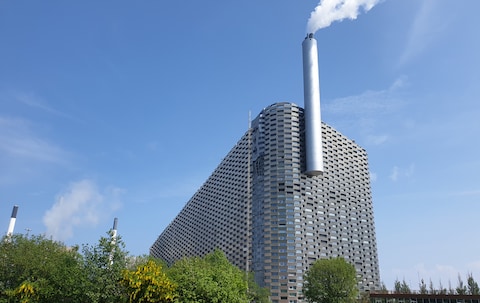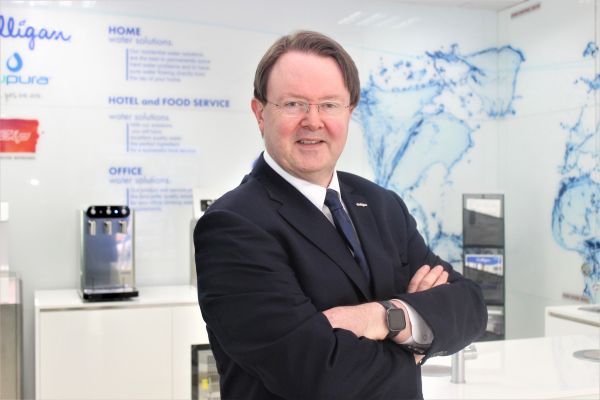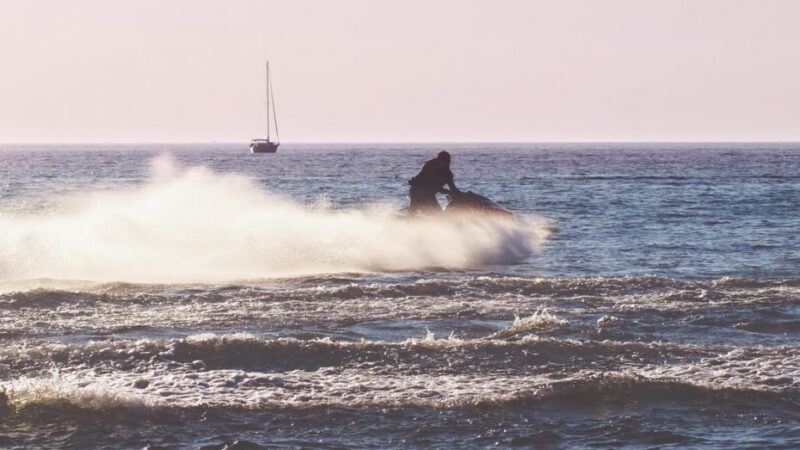“On Ski Sunday we take you to some of the most iconic ski pistes in the world – the Hahnenkamm in Kitzbühel, the Lauberhorn in Wengen, the Tofana in Cortina… and the rooftop of a power plant in Copenhagen.”
Even as I looked down the lens of the camera while delivering the opening link for our upcoming Ski Sunday piece, I knew I sounded crazy.
The comparison I was making between those long and undulating World Cup runs in the mountainous ski resorts of Austria, Switzerland and Italy, and a 490m artificial slope created in Denmark, was ridiculous. And yet this innovative concept is interesting enough to hold its own with any fan of skiing and snowboarding.
Created on top of a waste-to-energy power plant a 15-minute drive from the centre of Copenhagen, CopenHill opened October 4, 2019, and has four green plastic slopes of varying difficulty, as well as a terrain park, a slalom track, and other activities like a hiking trail and climbing wall.
Skiing on artificial snow is no new thing, especially in the UK. Torquay Alpine ski club opened on October 5, 1963 and is probably the oldest surviving dry slope in the world – I went and spoke, alongside local hero Eddie the Eagle, at the slope’s 50th birthday party celebration in 2013. Many of the UK’s best skiers, including our best ever Alpine skier Dave Ryding and freestyler James Woods, honed their skills at dry slopes, at Pendle Dry Slope in Lancashire and Sheffield Ski Village respectively.
I myself grew up whizzing down the eight-second slope of Sandown in Esher, with its notorious 90-degree bend. One of my most memorable milestones as a young ski racer was winning the World Dry Slope Championships at High Wycombe in the late 1990s. Truth be told there were few entrants from outside the UK!
So I am a confirmed fan of dry slopes, but why was I so very excited to visit CopenHill? The most obvious reasons are its size, and the view from the top. A 490m-long dry slope with a terrain park is far more sophisticated than any non-snow slope I have skied before. And looking out from the top, with a 360 view of the wind turbines in the water on one side and the pancake flatness of Copenhagen city on the other, is simply incredible.
But even more exciting for me was the prospect of being able to ski guilt-free in terms of environmental damage.
We have to face that the ski industry isn’t green. Yes we try, with notable campaigns such as the fantastic Protect Our Winters, created in 2007 by American professional snowboarder Jeremy Jones to mobilise the winter-sports community into positive action against climate change. But at the end of the day it is really hard for British skiers and snowboarders not to use planes and cars to get to the slopes and enjoy our sports.
While I’m delighted that there has been a move towards travelling to the mountains by train, encouraged by informative resources like ), it’s not realistic for me. Every week consists of visiting at least two different snowy countries for work during the winter, making it near impossible to avoid planes and 4×4 vehicles.
All of this meant I was thrilled to be visiting CopenHill, which has been created on top of the cleanest waste-to-energy power plant in the world.
The man behind it all, Bjarke Ingels, is an award winning, out-of-the-box thinking architect whose philosophy of what he calls ‘hedonistic sustainability’ helps him create and execute bold, brave projects far and wide. His company BIG (Bjarke Ingels Group) won a competition to design the power plant in 2011.
Ingels’ big idea was to add some fun elements to the project, but he wasn’t certain how he would do it. After making tentative plans he visited the site, and had a lightbulb moment on the way, thanks to a nearby wakeboarding, waterskiing and surfing park where people were using a cable loop to travel around the water.
As he collected his team together to propose roof top skiing on the power plant, he prepared himself for the mockery. Only it never came. Instead everyone got behind the idea, to the extent that his next step was to ask a small team to look into all the reasons why he should NOT follow through with the idea.
Their list was so minimal, the team so fired up, that the idea gained real momentum. And now Ingels’ answer to my question of “why?” is to say: “Because there are no mountains in Denmark.” Simple.
“We [Danes] have to travel six hours to the nearest skiing in Sweden,” Ingels says. “I want CopenHill to become a bedrock for the social and cultural life of the city. Sustainability can’t just be a battle for the environment, it has to increase the quality of life in order for it to be sustained. Hedonistic sustainability is for the future.”
This urban slope was a decade in the making, from having the original idea for entering the competition in 2009 to opening in 2019. And on a tour of the plant, which I was lucky enough to be given by Ingels himself, the complexity of changing the concept and look of a power plant, and adding the sport element, made it obvious why it took so long.
Ingels’ pride in and passion for this immense project was apparent as we walked around, as was his love of adventure movies, thanks to numerous film references, even in the practical side of the plant.
Each day 300 trucks drop their loads of waste in the base of the plant. Here, immense claws steered by two intimidatingly large gear-sticks controlled by a lone figure sitting in a deep, tall-backed leather swivel chair (looking just like a James Bond villain), move 400,000 tonnes of waste per year into giant combustion boilers to be incinerated at around 1,000ºC.
This creates enough electricity to power 60,000 homes and heat a further 160,000. And all this action takes place under a vast 85m high roof formed of two parallel diagonal panels that form a double cornered ski slope from the top of the building all the way down to the ground floor.
We started our tour inside the building by venturing up on a steel bridge that seems to float around 60m above the ground. Ingels has named it the Star Wars bridge – just one example of how he has infused the project with imagination.
When you visualise a power plant you probably think of ugly, dirty rectangular boxes with tall chimneys emitting a continuous plume of steam. Bar the top chimney, CopenHill is anything but. The windows and the mirrored outer face combined with the bright green plastic ski slope with grass poking through, and the surrounding trees and ferns, make it almost beautiful.
But, for me, the most epic sensory experience was standing at the top, boots done up and skis primed. As I watched the steam from a mini chimney set blow across the steep slope, I knew that in 10 seconds I would slice through it and continue arcing down the urban mountain. The only other time I have felt a similar rush was when skydiving through clouds – completely losing vision momentarily but knowing that in a millisecond I would plummet through and the world would open up before me.
At CopenHill, just the ski slope alone was a hefty research project, with the team spending over €30,000 travelling the world with top Danish skiers to test the different types of artificial snow. After considering surfaces from as far afield as China, and in the UK, they finally settled on a relatively unknown version designed by the father of a pair of Italian ski racers.
His artificial snow was not a business but a personal design for his back garden, intended to help further his sons’ skiing talent. The result is very different from the two surfaces I’ve been used to in the UK – the diamond-shaped bristles of Dendix (aka the thumb dislocator) and the carpet-like Snowflex that’s commonly used for freestyle slopes – tiny hexagonal shapes of stiff green plastic bristles.
Finally it was time to test the slope. I confess I snuck in a run before the cameraman for Ski Sunday had a chance to film me, because I could see others on the hill were struggling with grip. Yes I still have an ego on skis and didn’t want anyone to see me battling the surface!
So what was it like? I am not going to lie, I felt like Bambi on ice. And I didn’t even have the excuse of using rental kit, since I brought my own. At first I struggled to create edge angle and grip, and by the time I was at the bottom of the first steep slope, I was probably travelling at about 50mph, without much control. In fact, during the first few runs it took me about 30m to stop.
I realised that the skiing surface was much like sliding on ice, which takes a bit of getting used to, but the more energy and pressure you put into the skis, the more you can use normal on-snow technique.
I was surprised to see signs dotted all around the slope recommending running skis and snowboards over lubricating pads at the top of the slopes. These dispense a sticky green silicone intended to reduce friction that might slow you down. But I definitely didn’t need any more speed – and this from a downhill racer! It also proved to be a pain to clean my skis, and the muck got all over my jacket and gloves.
But that is really my only whinge about CopenHill.
I hot-lapped the slope – going up and down as quickly as I could, not socialising or stopping for anything – and found the experience of learning to ski on a completely different surface addictive. After three laps I was getting to grips (literally!) with how to work the surface and use the new way of skiing that I coach with my race team, CDC Performance.
I even started planning camps for my racers and long weekends to Copenhagen for skiing, somewhere that had never previously crossed my mind as a go-to ski destination. But if CopenHill is good enough to have a world record (the Poma drag-lift is the first ever ski lift bought by Denmark) then it’s good enough for me!
My final question for Bjarke Ingels was to ask what the likelihood would be of turning UK power plants into hedonistic projects like this – and he is interested in the idea. Way back he even looked into Battersea Power Station as a possible venue. There is much to do make snow sports greener – and with this concept, you can be environmentally friendly while having fun.
Is fun the new buzzword of environmentalism? Can skiing really be green? If my huge smiles at the end of amy day skiing CopenHill are anything to go by, then YES!
Essentials
Watch Chemmy Alcott’s CopenHill report on Ski Sunday this weekend, January 12 at 6.15pm on BBC2. Short term ski passes at Copenhill cost 150dkk (£17) an hour, with equipment hire packages including skis or snowboard, boots and helmet costing 120dkk (£13.50). A walk on the hiking track is free of charge. Find out more at . For more info about Chemmy Alcott’s CDC Performance Camps for children and adults visit .
Ski with Chemmy
Chemmy is also leading an exclusive Telegraph reader holiday to Val d’Isère in April 2020, from £999 including half-board accommodation and travel. Find out more or phone VIP Ski on 003301 739 580 to book.






Recent Comments